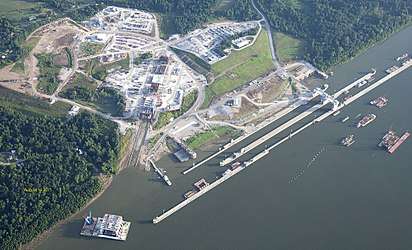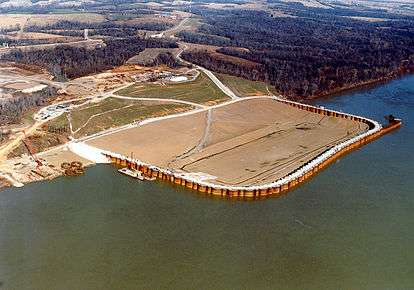Olmsted Locks and Dam
The Olmsted Locks and Dam is a locks and concrete dam on the Ohio River at river mile 964.4. The project is intended to reduce tow and barge delays by replacing the existing older, and frequently congested, locks and dams Number 52 and Number 53. The locks are located about 17 miles upstream from the confluence of the Ohio and Mississippi rivers at Olmsted, Illinois.
| Olmsted Locks and Dam (Locks and Dams 52 and 53 Replacement Project) | |
|---|---|
 Rendering of Olmsted Locks and Dam | |
| Location | |
| Coordinates | 37°11′01″N 89°03′50″W |
| Construction began | December 1995 |
| Opening date | August 2018 |
| Construction cost | Estimated $3 billion+ (as of February 2018) |
| Operator(s) | United States Army Corps of Engineers Louisville District |
| Dam and spillways | |
| Impounds | Ohio River |
| Height | 62 feet (19 m) |
| Length | 2,596 feet (791 m) |
The project is operational while the removal of Locks and Dams 52 and 53 should be completed around 2020. The project is both the largest and the most expensive inland waterway project ever undertaken in the United States.[1]
History
The US Congress, through the Water Resources Development Act of 1988[2] first approved a $775 million budget for the project in 1988 (October 1987 Price Levels). The lock chambers, completed in 2002, are 110 feet (34 m) wide and 1,200 feet (370 m) long.[3]
According to the US Army Corps of Engineers, the new dam and locks will reduce passage time to under one hour with the new system. Due to queuing at Lock and Dam Number 52 and Lock and Dam Number 53, it can take cargo traffic 15 to 20 hours each to transit the locks the Olmsted complex is intended to replace.[4]
When initiated the complex was projected to cost $775 million.[4] As of February 2018, the estimated cost of the project is over $3 billion.[5][4]
While the project was initially scheduled for completion in 1998, by 2016 it was projected to become operational between 2018[4][6] and by 2020, Locks and Dams 52 and 53 would be decommissioned.[7][8]
The United States Army Corps of Engineers (USACE), the Federal agency responsible for maintaining navigation on the USA's rivers, estimates the delay in completing the project results in a yearly loss of about $640 million to $800 million in lost benefits to the nation. While calculating these benefits is complex because of the amount of variables considered, it essentially takes into account the reduced costs industry (or businesses using the river for commerce) would experience if the Olmsted Project was operational versus the current means of transit through the aging and often unreliable Locks and Dams 52 and 53. These benefits further calculate the reduced costs in moving cargo through the river versus the next available cheapest alternative, usually by rail or by truck.[2]
In-the-wet construction
The Locks and Dams 52 and 53 Replacement Project, better known as the Olmsted Locks and Dam Project makes use of the innovative in-the-wet construction. When a dam is constructed on a small river, engineers usually create a cofferdam (or a enclosure) within a river and drain the water out of it to facilitate construction. However, building this entire project through the use of cofferdams would have been incredibly impeding to river traffic. As the hub of the Inland waterways, the largest transit point in the nation's river system where approximately 90 million tons of goods pass through each year, blocking large parts of the river would have caused major delays to river traffic even more so than evidenced at Locks and Dams 52 and 53.[9]

Engineers instead chose to construct the dam portion of the project using the in-the-wet technique, where concrete portions of the dam itself were built offsite at a concrete casting yard, transported into the river for placement, and placed on the bottom of the river, all with minimal disruption to the river.[10]

Problems with the project - cost increases
This has been perhaps the longest and largest civil works project in the history of the Corps of Engineers. Multiple delays, especially in funding have created a 30 year endeavor that has been inflated from a $700+ million price tag to over $3 billion in early 2018.[2]
The biggest contributors to these increases have been:
- Delays in funding and lack of availability of appropriations
- Costs increases of materials over time
- Low initial budget proposal for the project (engineers underestimated the initial costs of the project)
- In-the-wet construction
- Cost-reimbursable contracts (where the Government carries the majority of the risk of development)
- Unforeseen engineering problems
- Stretching of the budget (the USACE had and has other projects that require funds which were in turn taken away from Olmsted)
- Inflation
- Changes in design to the project
- Unpredictable river conditions
| Locks and dams of the Ohio River | ||
|---|---|---|
| Upstream: Smithland Lock and Dam |
Downstream: None on the Ohio River | |
References
- "Olmsted Locks and Dam". Louisville District. United States Army Corps of Engineers. Retrieved February 21, 2018.
- "Factors Contributing to Cost Increases and Schedule Delays in the Olmsted Locks and Dam Project" (PDF). Government Accountability Office. February 2017.
- "Olmsted Locks and Dam - Project Description". United States Army Corps of Engineers. Retrieved November 1, 2013.
- Kelley, Tyler J. (November 23, 2016). "Choke Point of a Nation: The High Cost of an Aging River Lock". The New York Times. Retrieved December 30, 2016.
- Schneider, Keith (August 18, 2014). "On Books Since 1988, Ohio River Dam Project Keeps Rolling Along". The New York Times. Retrieved December 30, 2016.
- Mariano, Nick. "Years overdue, billions overbudget: Olmsted engineers predict the project will be operational in 2018". The Southern Illioisian. Retrieved November 27, 2016.
- Schimmel, Becca (September 14, 2016). "'Sticky Wicket' Clogs Ohio River Traffic". WKMS NPR. Retrieved December 30, 2016.
- Cavagnaro, Hank. "Ohio River Locks and Dam 52 reopens". KFVS12.com. Retrieved November 27, 2016.
- "Engineering for Prefabricated Construction of Navigation Project" (PDF). United States Army Corps of Engineers. February 1, 2004.
- O'Bannon, Patrick (2009). Working in the dry: Cofferdams, in-river construction, and the United States Army Corps of Engineers (PDF). Pittsburgh District. Pittsburgh, Pennsylvania: United States Army Corps of Engineers.